|
Gibbon Documentaries
|
This page offers a list of, and comments on, video
or tv documentaries on gibbons. You might need to download Windows Media Player  , Apple QuickTime , Apple QuickTime  , or
other video player software to see the downloadable films or trailers. , or
other video player software to see the downloadable films or trailers.
If any of the information and references presented on this page are incorrect or
incomplete, please contact the webmaster. Please let me know, if you know a gibbon
documentary that is missing from this list. |
| |
Title: "Javan gibbon: Story
from Petungkriyono forest"
Original title: Owa Jawa: Cerita dari Hutan
Petungkriyono
Duration: 13 min
Year: 2010
Production: Inspiro Production (www.inspiroproduction.com)
Endangered Primate Conservation Project
Producer: Arif Setiawan
Director: Wisnu Prabowo
Editing: Iting
Camera: Wisnu and Teja Yuwana
Gibbon Locality: Petungkriyono forest, central Java, Indonesia
Language: Bahasa Indonesia. There is also a version with English subtitles.
Summary: This documentary presents a nice introduction to biology of, and conservation
issues regarding, the endangered Javan silvery gibbon (Hylobates moloch).
 Press this button to watch or download a low resolution
copy of the documentary (version with English subtitles). This may take some time,
considering the large size of the file (mp4-format, 44 MB). Press this button to watch or download a low resolution
copy of the documentary (version with English subtitles). This may take some time,
considering the large size of the file (mp4-format, 44 MB). |
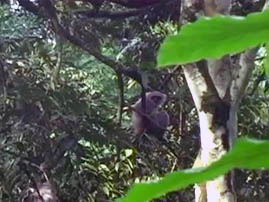
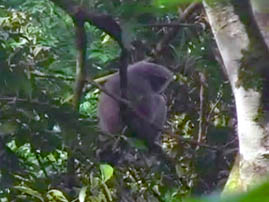
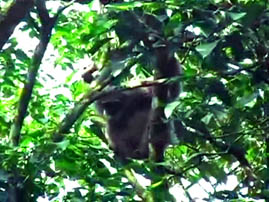
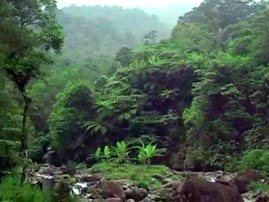 |
Title: "Cao vit gibbon census"
Duration: 19 min
Year: 2008 (filmed 2007)
Production: Wild China Film (www.wildchina.cn)
Copyright: Wild China Film (www.wildchina.cn) and Fauna & Flora International
(www.fauna-flora.org)
Gibbon Locality: Jingxi county, Guangxi province, SW China
Language: Mandarin. There is also a version with English subtitles.
Summary: This program documents a census survey of the cao-vit crested gibbon (Nomascus
nasutus) of China that was conducted in 2007. The only confirmed population of
this critically endangered ape occurs in a single patch of forest that covers parts
of Jingxi county in Guangxi province of southwestern China and a bordering area in
the Trung Khanh district of Cao Bang province (NE Vietnam). The total population
of this species is estimated at about 18 groups.
 Press this button to watch or download a low resolution
copy of the documentary (version with English subtitles). This may take some time,
considering the large size of the file (mp4-format, 122.1 MB). Press this button to watch or download a low resolution
copy of the documentary (version with English subtitles). This may take some time,
considering the large size of the file (mp4-format, 122.1 MB). |
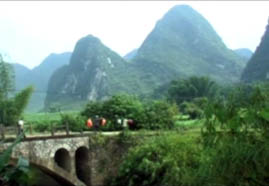
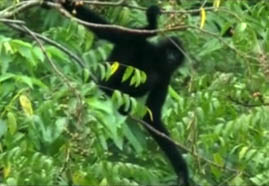
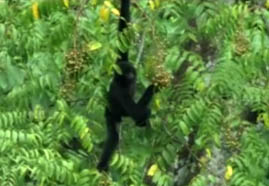
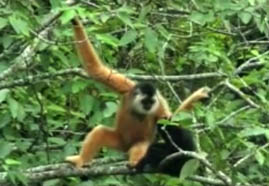 |
Title: "Wild China"
Duration: Six episodes of 60 min each
Year: 2008
Production: BBC Natural History Unit and China Central Television (CCTV). Filmed
entirely in high-definition (HD). Producers:
Phil Chapman, Gao Xiaoping
Gibbon Locality: Wuliang Mountains, Yunnan province
Series commercially available as 2-DVD set.
Internet host of the series in low resolutuion: www.mazalien.com/wild-china.html
Summary of the series: A nature documentary series on the natural history of China
revealing "the little-known natural treasures and secret wildlife havens of
China's wildest regions." Gibbon footage is shown in Episode 2 only.
Episode 2 (of 6): Shangri-La (First broadcast in the UK on 18 May 2008)
Duration: 60 min
Summary: This episode profiles
the rich biodiversity of south-western Yunnan province. Animals shown include, among
others, Yunnan snub-nosed monkeys, Temminck's tragopan, bear macaques, black giant
squirrels, Asian elephants, lesser bamboo bats, and black crested gibbons (Nomascus
concolor). The gibbon footage has a duration of about 2.5 minutes.
|
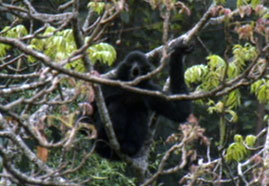
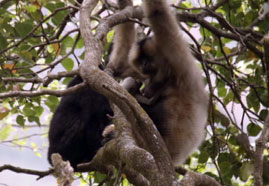
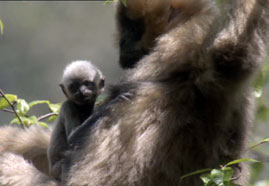
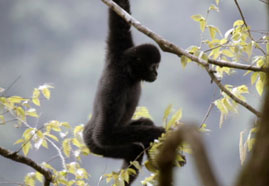 |
Titles: "Raising baby Iwani"
episodes 1 and 2
Duration: Two episodes of 30 min each of the series
"The Zoo Life at Auckland Zoo"
Year: 2006
Production: Greenstone Pictures, www.greenstonepictures.com/
Gibbon Locality: Auckland Zoo, New Zealand
Summary: After the death of his twin sister and rejection by his mother, the future
for Iwani - a six-week-old siamang gibbon at Auckland Zoo, New Zealand - looked bleak,
except for the help of senior primate keeper Christine Tintinger. Despite the zoo
having a policy restricting human interaction with its animals, Christine became
a surrogate mother for baby Iwani. This documentary follows Christine as she develops
an integration plan that would see little Iwani stay in as much close contact with
his family as possible. Each stage of the integration took months, with Christine
relying on instinct and over 25 years of experience as a primate keeper to judge
when the time was right to introduce Iwani firstly to his brother, then father, and
finally his mother.
|

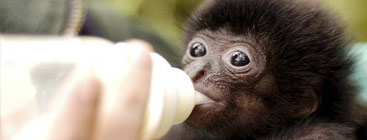
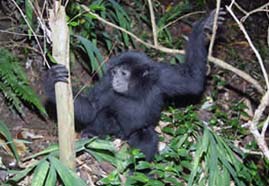 |
Title: "The life of mammals"
Duration: 430 min
Year: 2002
10 episodes
Production: BBC, in conjunction with The Discovery Channel
Gibbon Locality: Khao Yai National Park, Thailand
Summary of the series: A natural history television series devoted to mammals. It
consists of ten episodes, written and presented by David Attenborough. It premiered
on BBC 1 on 20 November 2002.
Episode 8 (of 10): Life in the trees
Duration: 43 min
Summary: A range of adaptations from sucker-feet to gripping tails help the tree
dwellers to survive, and in the dark forest super senses come in to play. This part
includes a 2-minute gibbon section. It is focusing on the gibbons' fast and acrobatic
brachiation through the tree-tops.
Comments: Some of the gibbon footage used stems from the BBC documentary "Up
with the gibbons" of 1999 (see below).
|
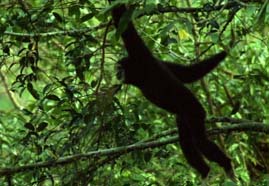
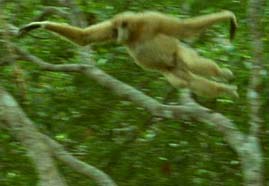
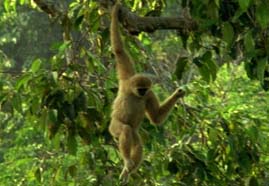 |
Title: "Mission Kalaweit.
La protection des gibbons en Indonésie"
Duration: 25 min
Year: 2001
Production: France 5 television. Available from www.vodeo.tv
Gibbon Locality: Kalawait Rehabilitation Centre, Kalimantan, Indonesia
Original French summary of this program (from www.vodeo.tv): "A Bornéo,
près de Palangkara, la capitale de la province, se trouve une clinique vétérinaire
spécialisée dans la protection des primates. En Indonésie, les
orangs-outangs et les gibbons sont victimes de la déforestation et de la chasse.
Les gibbons sont également arrachés à leur milieu naturel par
les habitants: ils sont plus de 150 dans la seule ville de Palangkara à en
posséder un comme animal de compagnie. A 20 ans, Aurélien Brûlé
est le tout jeune directeur du premier programme de protection des gibbons d'Indonésie.
Son but: reconstituer les familles de singes et les réhabituer progressivement
à la vie sauvage. En suivant l'action de ce jeune homme passionné par
les gibbons, ce documentaire alerte sur les dangers qui menacent ces singes. Il montre
notamment toute la difficulté à les réadapter à leur
milieu naturel."
Summary: This program shows the gibbons (mostly Hylobates agilis albibarbis)
at the Kalaweit Gibbon Rehabilitation Centre in Borneo and documents the conservation
efforts by Aurélien Brûlé, the founder of the centre.
 Press this button to watch or download a trailer of the
documentary (mov-format, 3.7 MB, from www.vodeo.tv). Press this button to watch or download a trailer of the
documentary (mov-format, 3.7 MB, from www.vodeo.tv). |
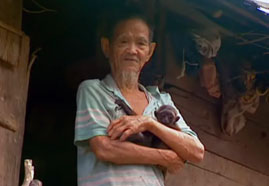
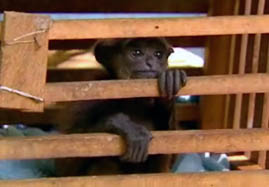 |
Title: "Les Chroniques
de l'Asie sauvage" or "Chroniques de la jungle perdue" or "Untamed
Asia"
Duration: 312 min
Year: 2001
A film series of 6 episodes by Laurent Frapat and Frédéric Lepage.
Narrator: Pierre Arditi
Production: Télé Images Nature, in collaboration with France 3.
Gibbon Locality: Khao Yai National Park, Thailand, and unspecified zoos
Original French liner notes of the DVD edition: "Nous voici replongés
au pied des monts Thanen Thong Dan, au coeur de la jungle sauvage du sud est asiatique.
L'occasion de partager les aventures de Pra Djann la tigresse, de ses enfants Koumpa
et Tcha, de Wan l'éléphante et de Sikao et Wao les cigognes. Pierre
Arditi nous entraîne par son talent au coeur de la jungle perdue dans une aventure
hors du commun à la découverte des naissances, des morts, des premiers
pas, des amours et des peurs de la faune sauvage."
Summary of the series: This programme documents the wild life in the jungles of South-east
Asia. According to the liner notes, the footage was taken in the Tanen Tong Dan mountain
range in western Thailand. The series includes several sections on gibbons in episodes
1, 4, 5 and 6. Other primates featured include the long-tailed macaque (Macaca
fascicularis), the pig-tailed macacque (M. leonina), the Phayre's leaf
monkey (Trachypithecus phayrei), and the Bengal slow loris (Nycticebus
bengalensis).
"Episode 1 (of 6): L'archipel vert"
Duration: 52 min
Summary of the gibbon section: A pair of pileated gibbons (Hylobates pileatus)
exhibits rapid locmotion, unusual positionary behaviour, and duet singing.
Comments: The gibbon section has a duration of 2.7 minutes, and the footage obviously
is of captive gibbons. In the background, calls of other pileated gibbons can also
be heard. During the gibbon section, the narrator explains that male lar gibbons
have black fur and females are blonde. While this is true of the pileated gibbons
shown in the film, it does not apply to white-handed or lar gibbons (H. lar)
which are currently recognised as a distinct species.
"Episode 4 (of 6): Samsara"
Duration: 52 min
Original French liner notes on the gibbon section: "... A trente mètres
de haut, les gibbons ont établi leur territoire. Les cris d'alerte de leurs
congénères interrompent une séance d'épouillage. ..."
Summary of the gibbon section: A pair of nothern white-cheeked crested gibbons (Nomascus
leucogenys leucogenys) exhibits social grooming and duet singing.
Comments: The gibbon section has a duration of 3 minutes. The narrator claims that
the gibbon were filmed in the wild, but this is not true. White-cheeked crested gibbons
are not distributed in Thailand but occur only east of the Mekong river. In the background,
calls of a male pileated gibbon (Hylobates pileatus) and a female white-handed
gibbon (H. lar) can also be heard, which makes it very obvious that the gibbons
were filmed at a zoo.
"Episode 5 (of 6): Les prisonniers"
Duration: 50 min
Original French liner notes for the gibbon section: "Deux tigres indochinois,
Pang et Sua, jouent innocemment dans la jungle. Mais ils ont empiété
sur le territoire de Taloum le gibbon qui, habilement suspendu aux petites branches,
vient littéralement leur tirer les oreilles..."
Summary of the gibbon section: A young white-handed gibbon (Hylobates lar)
playfully keeps attacking two young tigers without ever getting caught by them. The
gibbon appears to enjoy it, the tigers maybe less so.
Comments: I am not sure where the gibbon footage of this episode was filmed, but
it obviously shows captive animals. It may have been filmed at the Khao Pratabchang
Wildlife Breeding Center in Rachaburi, West Thailand. The short gibbon section (3
min 20s) of this episode is very popular: An edited version of it was presented in
tv shows of various countries and can be downloaded from several websites on "funny
movies".
 Press this button to watch or download a low resolution
copy of the gibbon & tiger clip (wmv-format, 8.8 MB). Press this button to watch or download a low resolution
copy of the gibbon & tiger clip (wmv-format, 8.8 MB).
"Episode 6 (of 6): L'envol"
Duration: 50 min
Summary of the gibbon section: Short takes of locomotion, feeding, and calling behaviour
of white-handed gibbon (Hylobates lar).
Comments: This episode appears to the only one of
the series to include footage of wild gibbons. The gibbon footage has a duration
of 4 minutes and was probably filmed at the Khao Yai National Park.
|
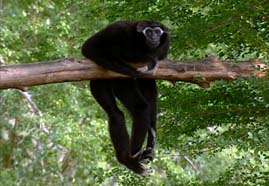
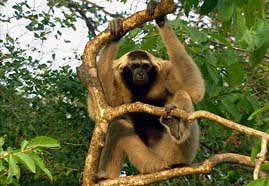
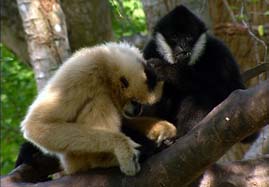
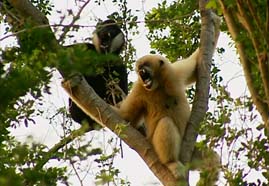
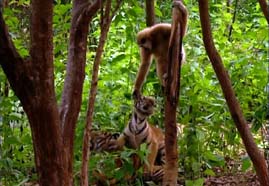
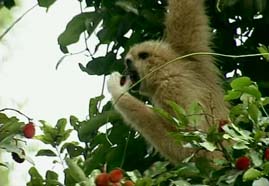
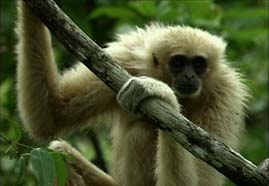
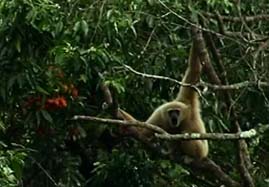 |
Title: "Thailands Gibbons
- Akrobaten im Urwalddach"
Duration: 35 min
Year: 2001
Produced by VOX, Germany
Gibbon Localities: Phuket Gibbon Rehabilitation Centre, and Khao Yai National Park,
Thailand
Summary: The first part of this documentary shows the white-handed gibbons (Hylobates
lar) at the Phuket Gibbon Rehabilitation Centre and visits some of the gibbons
that have been released on one of the small islands in the Phangnga Bay. The documentary
then portrays a scientific field study that is being conducted on the social life
of white-handed gibbons at the Khao Yai National Park in Thailand. Special attention
is paid to the group of the adult female "Brenda". Her group is particularly
interesting because it includes a second, unrelated female, and because the group's
adult male is expelled by an immigrating male.
|
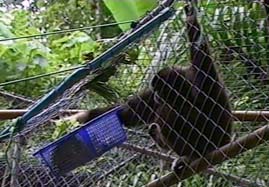
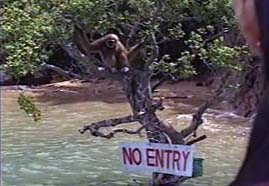
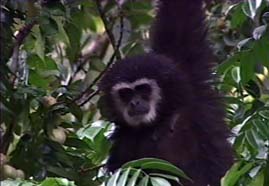
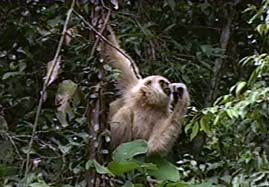 |
Title: "Gibbons Release
(Jack Hanna's Animal Adventures)"
Duration: 20 min
Year: 2001
Produced and distributed by VideoTours, Inc. = VT Entertainment, 1070 Commerce Drive,
Perrysburg, OH 43551, U.S.A. (www.vtetv.com ). Also available through http://66.70.186.203/
Gibbon Locality: Phuket Gibbon Rehabilitation
Summary: Jack Hanna visits the Gibbon Rehabilitation Project of the Wild Animal Rescue
Foundation in Phuket, Thailand to assist in the release of the "Phuket Four,"
rehabilitated white-handed gibbons (Hylobates lar). At the Project, Jack assists
in the preparation food for the captive gibbons. The gibbons are seen swinging, running
along the ground and eating. Territorial vocalizations can be heard. Kathaleen Hanna
visits an island in the Phangnga Bay that is home to four rehabilitated gibbons.
Hanna also visits a rubber tree area to show how natural rubber is collected and
processed.
|
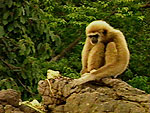 |
Title: "Singing apes"
Duration: 30 min
Year: 2000
A film by Jan Röed & Magnus Enquist, with Björn Merker, Sweden. Distributed
by Charon Film (www.charon.se)
Gibbon Localities: Khao Yai National Park, Thailand; Siberut, Indonesia; Halimun,
Westjava, Indonesia; Gunung Leuser, Sumatra, Indonesia; NE Assam, India, and several
zoos
Summary: This program documents differences in the calls and vocal interactions among
various gibbon species. It examines the hypothesis that the study of gibbons may
shed light on the evolution of human communication and bipedal locomotion. Wild gibbons
shown include white-handed gibbons (Hylobates lar), hoolocks (Hoolock hoolock),
Javan silvery gibbons (Hylobates moloch), Kloss's gibbons (H. klossii),
and siamangs (Symphalangus syndactylus). In addition, footage of captive Mueller's
gibbons (H. muelleri) and yellow-cheeked crested gibbons (Nomascus gabriellae)
is shown.
Comments: The first and probably the only documentary which includes footage from
several wild gibbon populations. In some scenes (e.g. the Kloss's gibbons footage),
gibbon calls were copied over footage of non-singing gibbons. Strong emphasis on
the relevance of gibbon songs for understanding the evolution of human language.
|
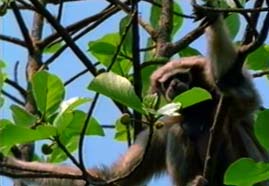
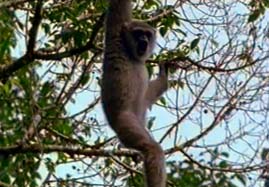
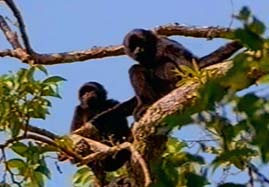
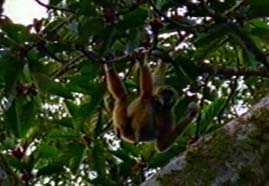 |
Title: "Wildes Vietnam"
Duration: 90 min
Year: 2000
Buch & Regie: Sylvia & Frank Koschewski. A Telekine-Produktion im Auftrag
des MDR, in collaboration with ARTE. Scientific advisor: Jörg Adler
Gibbon Locality: Cuc Phuong Primate Rescue Station, Vietnam
Summary: This program consists of two episodes of 45 minutes duration each and exploring
the wildlife of Vietnam. Episode 1 includes the first good footage of wild Cat-Ba
leaf monkeys. There is also some footage of calling southern white-cheeked crested
gibbons (Nomascus leucogenys siki).
Comments: The gibbon footage - we are led to believe by the narrator - was taken
of wild gibbons in the Mekong delta. This is, of course, not true. Gibbons never
occurred in the Mekong delta, and the gibbon footage was shot of captive gibbons
at the Cuc Phuong Primate Rescue Station.
|
Title: "Monkeys [ and apes
of Asia ]"
Duration: 21 minutes
One episode of the TV series "Safari" (Outdoor Life Channel)
Year: 2000
Executive producer: Paul Sharratt, producer: David L. Stanton, associate producer:
Chris Merrill, narrator: John Ross, production: Starcast International, Associated
Television International.
The episode is available on DVD under the title "Wildlife Paradise - Monkies"
in Great Britain (released in 2005) and under the title "Affen" in German-speaking
countries (released in 2006)
Gibbon locality: Unspecified zoo
Summary: This episode explores the behavior of four species of Asian primates: Whie-handed
gibbon (Hylobates lar), Japanese macaque (Macaca fuscata), northern
pigtail macaque (M. leonina), and proboscis monkey (Nasalis larvatus).
The gibbon section has a duration of 3.4 minutes and mainly shows gibbons in suspensory
locomotion.
Comments: Although this episode is introduced by the words "The song of the
gibbon echoing through the forest is something you never forget", gibbon songs
are not featured at all and only a few gibbon hoots are heard in the episode. The
gibbon section mainly consists of footage of captive individuals. The most unusual
scene shows a gibbon eating a crab - ironically accompanied by a comment on the gibbons'
feeding primarily on fruit. |
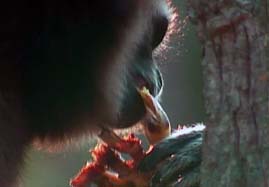
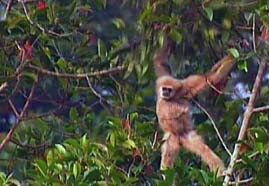
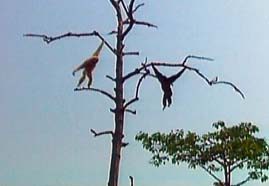 |
Title: "Through the eye
of the gibbon"
Duration of gibbon video clip: 37 sec
Year: 1999
Gibbon Locality: Nam Kan Protected Area in Bokeo Province, Laos.
Citation: Forespace (1999): Through the eye of the gibbon. Wildlife conservation
& tree-top ecotourism with the hill tribes of northern Laos. Nam Kan Protected
Area, Bokeo, Laos, Version 1.0 (Multimedia CD-ROM). Ministry of Information &
Culture, Hoei Sei, Laos
Summary: This is a promotion CD-ROM for the Forespace ecotourism project. It inlcudes
one short video clip showing western black crested gibbons (Nomascus concolor).
Comments: The gibbon sounds in the clip are not synchronous with the film.
 Press this button to watch or download a low resolution
copy of the film (mpg-format, 6.4 MB). Press this button to watch or download a low resolution
copy of the film (mpg-format, 6.4 MB).
|
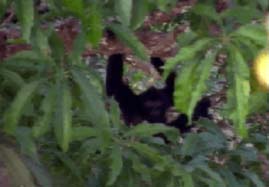
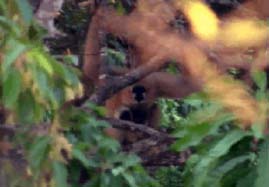 |
Title: "Up with the gibbons"
Duration: 30 min
Year: 1999 (filmed 1998-1999)
BBC (-NHU), TV series "Wildlife on One"
Producer: Phil Chapman, camera: Justine Evans, narrator: David Attenborough, series
editor: Sara Ford
Gibbon Locality: Khao Yai National Park, Thailand
Summary: This documentary examines the social life of white-handed gibbons (Hylobates
lar) at the Khao Yai National Park in Thailand, and follows a day in the life
of three rival gibbon families, the Andromeda- or A- group, the Cassandra- or C-group,
and the S-group.
Comments: Good movie with some really beautiful gibbon footage and some rare bits
inclluding an interaction between a gibbon and a giant squirrel, and a gibbon copulation.
The gibbon copulation calls, however, are not the real thing.
|
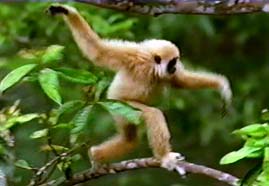
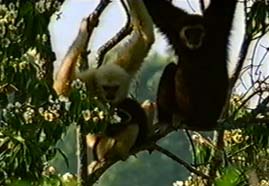
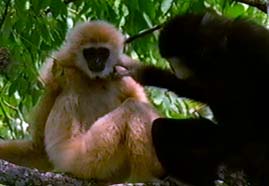
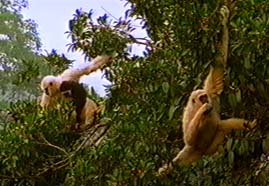 |
Title: "The living Edens:
Thailand, jewel of the Orient"
Duration: 45 min
Year: 1999 (filmed 1998-1999)
A production of ABC / Kane Productions, in association with Trebitsch Produktion
International GmbH and PBS. Produced by Bruce Reitherman. Worldwide distribution
by Devillier Donegan Enterprises. More information: http://www.pbs.org/edens/
Gibbon Localities: Zoo footage and possibly Khao Yai National Park
Summary: This program exlpores the wildlife of Thailand and inicludes footage of
white-handed gibbons (Hylobates lar).
Comments: The included gibbon footage is of little scientific value, because the
silent footage of the singing white-handed gibbons is underlaid with calls of siamangs
(Symphalangus syndactylus) and white-cheeked crested gibbons (Nomascus
leucogenys).
|
Title: "Wild Indonesia"
Duration: 180 min
Year: 1999
A Tigress production in association with Devillier Donegan Enterprises & PBS;
writers: Anne MacLeod, James Sasse; executive producer: Jeremy Bradshaw.
Gibbon Locality: ? Sumatra, Indonesia
Summary: This program is divided into three episodes, "Where worlds collide,"
"The mystery of Sulawesi," and "Creatures of island kingdoms."
The first episode discusses how Indonesia's wildlife is unique because they have
animals that came from Asia and Australia. Sumatra, Bali, and New Guinea are looked
at in detail. Primates shown include Thomas's langur (Presbytis thomasi),
the siamang (Symphalangus syndactylus), the agile gibbon (Hylobates agilis),
the Sumatran orangutan (Pongo abelii), and the long-tailed macaque (Macaca
fascicularis). In the second episode, the mysteries of the unusual animals on
the island of Sulawesi are unraveld. Primates shown include the tarsier (Tarsius
sp.) and the crested black macaque (Macaca nigra). The final episode discusses
conditions unique to an island and how they are formed, such as colonization by seed
dispersal.
|
Title: "The living Edens:
Borneo, an island in the clouds"
Duration: 60 min
Year: 1998
Produced by Neil Lucas ABC/ Kane Productions International, Inc. and Devillier Donegan
Enterprises
Gibbon Locality: ? Borneo
Summary: This program exlpores the variety of life unique to Borneo, in its caves,
forests, and reefs. Among primates, it looks at the life history of Bornean orangutans
(Pongo pygmaeus), and shows other primates including gibbons (Hylobates
sp.), the silver leaf monkey (Trachypithecus cristatus), the long-tailed macaque
(Macaca fascicularis), and the proboscis monkey (Nasalis larvatus)
in the mangrove swamps.
|
Title: "Les Gibbons de
Phuket" or "Save the playful gibbons"
Duration: 52 min
Year: 1997
A film by Guillaume Vincent. Eolis Productions, with Télé Images /
I.T.I. (www.teleimages.com).
Gibbon Localities: Pet gibbon owners in Pattong, and Phuket Gibbon Rehabilitation
Centre, Thailand
Summary: Documents the use of white-handed gibbons (Hylobates lar) as pets
in Thailand. Some of the pets are transferred to the Phuket Gibbon Rehabilitation
Centre. The rehabilitation process is described. A family group of three gibbons
is released on one of the small islands in the Phangnga Bay.
Comments: A 26 min version of this documentary seems to exist as well.
|

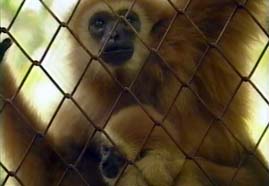
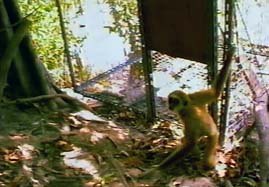
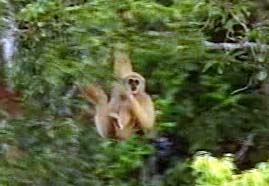 |
Title: "Jarunee the singing
ape"
Duration: 49:37 min
Year: 1997 (produced 1996)
Produced by Grainger Television Australia, www.graingertv.com. Director, writer and
narrator: Greg Grainger
Gibbon Localities: Pet gibbon owners in Bangkok, Krabok Koo Rehabilitation Centre,
Hua Hin Wildlife Rescue Center, Phuket Gibbon Rehabilitation Centre, and Khao Yai
National Park, Thailand.
Summary: Documents the use of white-handed gibbons (Hylobates lar) as pets
in Thailand. Some of the pets are transferred to the Krabok Koo Rehabilitation Centre,
administrated by the Forestry Department and the Wild Animal Rescue Foundation. Two
of these captive gibbons give birth to a female infant, "Jarunee". When
Jarunee is six months old, the family group is temporarily transferred to Hua Hin.
The documentary also shows how and why some gibbons of the Phuket Gibbon Rehabilitation
Centre are released on small islands in the Phangnga Bay. The film switches back
to Jarunee, who is brought to the Khao Yai National Park. She is released into the
wild and re-joins her parents and another rehabilitated gibbon infant who have been
released there earlier.
Comments: Not all footage of "Jarunee" and her parents appears to feature
the same gibbon individuals. The documentary also includes some interesting footage
of a gibbon birth at Krabok Koo, a gibbon catching and eating fish at Hua Hin, and
an unusually large gibbon group kept on an island at Hua Hin.
|
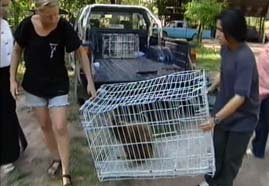
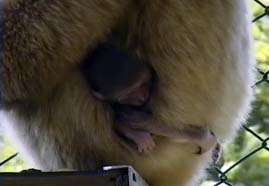
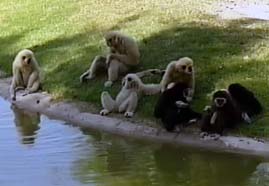
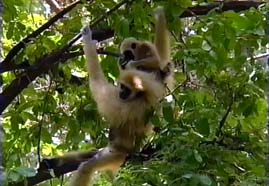 |
Title: "Gibbons - Affenliebe,
Affentreue" or "Gibbons - Von Affenliebe und Affentreue"
Duration: 30 min
Year: 1996
A film by Felix Heidinger. Kamera: Klaus Axthammer. Produced by Bayerischer Rundfunk
BR, Germany.
Gibbon Locality: Khao Yai National Park, Thailand.
Summary: This documentary examines the social life of white-handed gibbons (Hylobates
lar) at the Khao Yai National Park in Thailand and also portrays a behavioural
field study that is being conducted on the these gibbons. Same footage as in the
film "Heisst Affenliebe auch Affentreue?" (listed below), but 15 minutes
shorter.
|
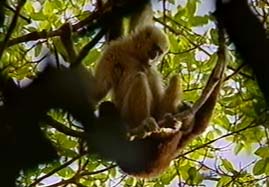
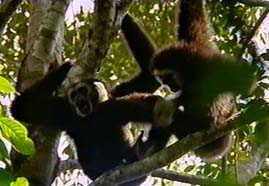
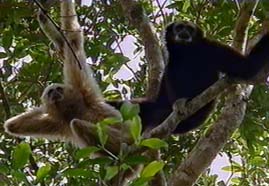 |
Title: "Heisst Affenliebe
auch Affentreue?"
Duration: 45 min
Year: 1996
A film by Felix Heidinger. Kamera: Klaus Axthammer. Produced by Bayerischer Rundfunk
BR, Germany.
Gibbon Locality: Khao Yai National Park, Thailand
Summary: This documentary examines the social life of white-handed gibbons (Hylobates
lar) at the Khao Yai National Park in Thailand and also portrays a behavioural
field study that is being conducted on the these gibbons. Special attention is paid
to the group of the adult pair "Fearless" and "Andromeda" and
the occurrence of extra-pair copulations.
Comments: Includes a particularly nice sequence of a gibbon mother helping her juvenile
offspring to cross a gap between the tree crowns, and footage of a gibbon copulation.
|
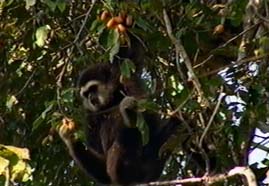
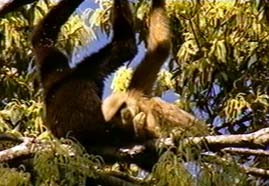
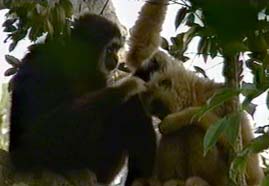 |
Title: "Singing apes of
Khao Yai"
Duration: 30 min
Year: 1994
BBC and Partridge Films (www.partridgefilmsltd.visualnet.com), TV series: Wildlife
showcase
Producer: Sarah Cunliffe, camera: Richard Davies and James Gray, narrator: Ian Holm,
executive producer/series producer: Michael Bright
Gibbon Locality: Khao Yai National Park, Thailand
Summary: Programme follows a family group of white-handed gibbons (Hylobates lar)
through their natural habitat in the Khao Yai National Park in Thailand and visits
the animal market of Bangkok where young gibbons are illegally offered for sale (not
shown).
Comments: Some strange cuts. Gibbon call soundtrack not always synchronous with the
footage, and some "gibbon" calls heard in the documentary (especially those
of the infant gibbon) do not appear to be real gibbon calls. The footage referred
to the focal family group also includes some footage of unrelated gibbon individuals
and of captive animals.
|
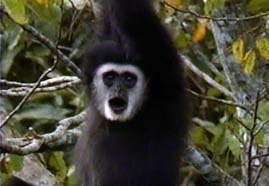
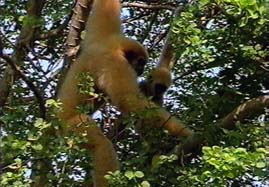
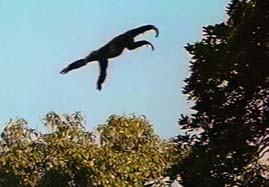
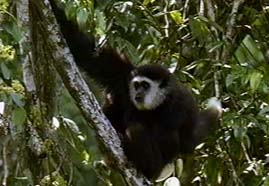 |
Title: "A-Group: One instance
of gibbon social organization"
Duration: 13 min
Year: 1987
Produced by Duane Quiatt, University of Colorado-Denver
Gibbon Locality: Khao Yai, Thailand
Summary: Filmed at the Khao Yai National Park in south central Thailand, this program
examines the "household" structure of a group of 5 white-handed gibbons
(Hylobates lar). Behaviors shown include grooming, leaping, brachiation and
duet calls.
|
Title: "Tree shrews and
gibbons"
Duration: 22 min
Year: 1987
Produced and distributed by Charles K. Wilks, Dept. of Anatomy and Human Biology,
University of Western Australia
Gibbon Locality: ?
Summary: This compilation of footage includes a silent 11 min segment of the common
tree shrew (Tupaia belangeri) and a 11 min segment, with sound, of gibbons.
The tree shrew is captive, and is shown scratching, self-grooming, climbing, eating
and defecating. The gibbons are shown brachiating and climbing. Most of the time,
however, they are at rest, showing limb postures when idle. A lone gibbon gives a
continuous "whoop" sound, and the vocalizations of a group of gibbons can
be heard.
Comments: The gibbon footage appears dark and fuzzy, apparently shot on an overcast
day.
|
Title: "Pangandaran and
the silver leaf monkey"
Duration: 20 min
Year: 1987
Distributed by John Fowler and Karen Kool, Instructional Resources Unit, Australian
National University, Canberra, Australia
Gibbon Locality: Pangandaran Nature Reserve, Java, Indonesia
Summary: Contains footage of Trachypithecus auratus, Presbytis comata,
Hylobates moloch, Macaca fascicularis, and Nycticebus coucang.
Comments: Gibbons do not naturally occur at Pangandaran NR. The gibbon footage was
taken of a captive gibbon that was released by government officials at Pangandaran
in either 1984 or 1985.
|
Title: "Gibbon group research
on Laulanui island, Hawaii"
Duration: 9 min
Year: 1976
Produced by Aristide H. Esser, Research Center of Rockland State Hospital
Gibbon Locality: Captive gibbon peer-group on Laulanui island, Hawaii
Summary: This video documents the temporary relocation of three gibbons (Hylobates)
from Thailand onto a small Hawaiian island, the observational and experimental methodology
of the research, and the behavior interactions of the gibbons. Shows integration
of the gibbons into a group, dominance.
|
Title: "Activity characteristics
of gibbons (Hylobates lar), Part 3: Social behavior"
Duration: 17 min
Year: 1974
Produced by Clarence R. Carpenter, Pennsylvania State University. Distributed
by Penn State Audio-Visual Services.
Gibbon Locality: Captive gibbon colony on Hall's Island, Bermuda
Summary: Social behavior in young adult white-handed gibbons (Hylobates lar)
on Hall's Island is observed. Behavioral components of play include wrestling, chasing,
play biting, play face, spinning and somersaulting. Play is shown to be both social
and individual, and takes up one-third of the gibbons' waking day. Communicative
behavior patterns are shown during interactions and pair formation. This film shows
use of core of territorial ranges as pair and/or individual sleeping sites. Examples
of vocalizations are also shown and heard.
|
Title: "Activity characteristics
of gibbons (Hylobates lar), Part 2: Locomotion"
Duration: 16 min
Year: 1974
Produced by Clarence R. Carpenter. Produced and distributed by the Penn State Audio-Visual
Services
Gibbon Locality: Captive gibbon colony on Hall's Island, Bermuda
Comments: Six individual white-handed gibbons gibbons (Hylobates lar) on Hall's
Island exhibit basic patterns of semi-vertical trunk orientation in walking and swinging,
which may represent one phase in the evolution of human upright posture. This program
illustrates individual variation in locomotion; suspensory behavior (hanging by hands
and feet); brachiation, swinging, climbing, walking (on ground, across branches,
and across a rope), and leaping. A slow-motion section reveals details of locomotion.
|
Title: "Activity characteristics
of gibbons (Hylobates lar), Part 1: Ecology and maintenance behavior"
Duration: 23 min
Year: 1974
Produced by Clarence R. Carpenter. Distributed by Penn State University Audio-Visual
Services
Gibbon Locality: Captive gibbon colony on Hall's Island, Bermuda
Summary: Depicts six gibbons (3 normal control, 3 with electrode implants) on Hall's
Island. This artificial enviroment's primary use is storage of animals for physiological
studies; its secondary use is for observation of gibbon behavior such as foraging,
feeding, individual grooming, resting and sleeping. The animals are shown acclimating
to their new environment.
|
Title: "Gibbon research
in a designed environment"
Duration: 11 min
Year: 1973
Produced by Clarence R. Carpenter, Lori Baldwin, and Geza Teleki. Distributed by
Penn State Audiovisual Services
Gibbon Locality: Captive gibbon colony on Hall's Island, Bermuda
Summary: Hall's Island, Bermuda, provides a free-ranging environment for a group
of 6 white-handed gibbons, Hylobates lar. The island's facilities were designed
for naturalistic behavioral research and for rehabilitation of captive gibbons. Within
the framework of a typical day of research, the film shows the observation and maintenance
facilities, techniques used in the recording of behavioral observations and the types
of gibbon behavior patterns observed on the island. These behaviors include locomotion
(walking, brachiating, leaping), drinking with cupped hand, foraging ground cover,
social play, sleeping and human-animal interactions.
|
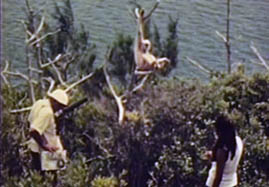
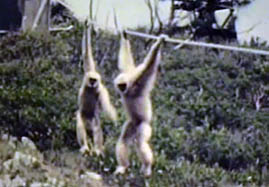
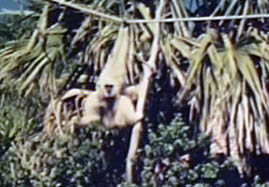
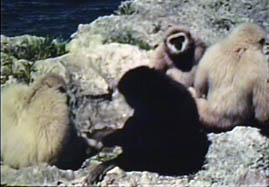 |
Title: "Gibbon locomotion"
Duration: 6 min
Year: 1971
Produced by Aristide H. Esser with the support of International Psychiatric Research
Foundation, New York. Distributed by Penn State Audio-Visual Services. Colour, silent.
Gibbon Locality: Captive gibbon peer-group on Laulani Island, Hawaii
Summary: Shows locomotion of free-ranging group of young white-handed gibbons, Hylobates
lar, on Laulani Island, Hawaii. Includes brachiating in slow and normal motion,
winding in and out of trees, trail leading, walking and running, walking and brachiating
while foraging for berries, and drinking using cupped hand.
|
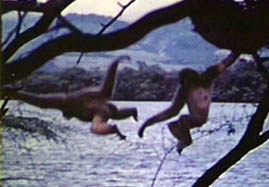
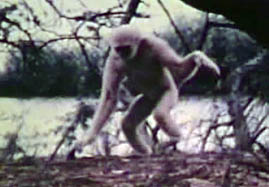
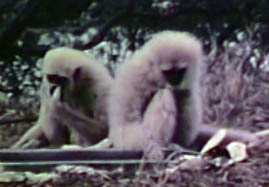
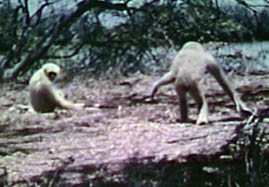 |
Title: "Survey of the primates"
Duration: 38 min
Year: 1970
A film by Duane M. Rumbaugh, Austin H. Riesen, and Robert E. Lee. Appleton-Century-Crofts,
New York, in cooperation with The San Diego Zoological Society. Copyright: Meredith
Corporation. Colour. Narrator: Robert E. Lee
Gibbon Locality: San Diego Zoo and Yerkes Regional Primate Research Center, Atlanta.
Summary: Primates are defined by 10 criteria: generalized skeleton; highly mobile
digits (and often an opposable thumb); tactile pads on the fingers; abbrevation of
snout or muzzle (excepting baboons); perfection of binocular vision; smell and other
senses de-emphasized by sight; fewer teeth; increase in size and complexity of brain
cortex; nourishment of fetus before birth; upright posture or bipedalism; and prolongation
of infant dependency upon parents. Compares traits among primates in evolutionary
perspective, from tree shrews to wet-nosed primates, Old World monkeys, New World
monkeys, and small and great apes. Discusses anatomical, social, and maturational
differences, as well as geographical distribution, habitats, intelligence, diet,
dentition, learned behavior, manual dexterity, and territoriality. Includes footage
of white-cheeked crested gibbons (Nomascus leucogenys), a white-handed gibbon
(Hylobates lar), siamangs (Symphalangus syndactylus), and a hybrid
gibbon (probably a lar x moloch hybrid), of a total duration of 2 min
40 s.
Comments: One short scene (19 s) with the hybrid shows a rare example of tool use
by a gibbon.
|
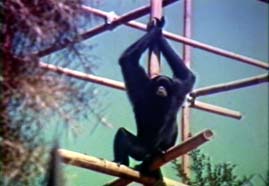
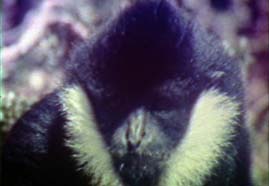
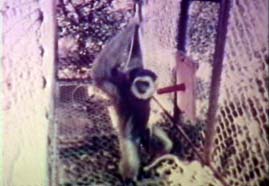 |
Title: "Hylobates lar
(Hylobatidae) - Fortbewegung im Geäst" [Hylobates lar (Hylobatidae)
- Locomotion on branches]
Duration: 7.5 min
Year: production 1965, publication 1967
Author: Cornelis Naaktgeboren (Amsterdam). Produced by Cornelis Naaktgeboren (Amsterdam)
and W. C. van Asperen (Amsterdam). Published and distributed by IWF, Göttingen
(Germany); www.iwf.de, ordering number: E 1107. b&w, silent.
Gibbon Locality: Opel Zoo, Kronberg im Taunus, Germany
Summary: The film documents the locomotion methods
of several gibbons (Hylobates lar) in branches. On horizontal branches the
biped gait is most usual, with the fore-extremities being used for balance as far
as possible. In hand over hand travelling, the fore-extremities play the major role
and the hind-legs only touch the branches very occasionally. The arms are again chiefly
used for rope-swinging, and, similarly, for leaping from branch to branch.
|
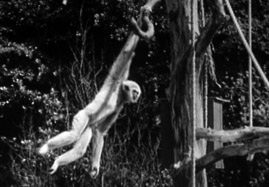
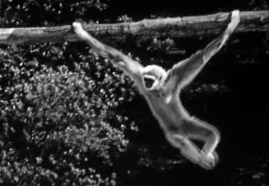
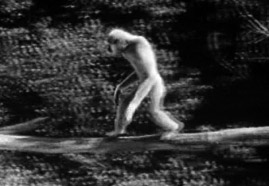 |
Title: "Characteristics
of gibbon behavior"
Duration: 11 min
Produced by Clarence R. Carpenter
Black and White; sound
Copyrighted: 1942
Distributor: Penn State University PCR (PSUPCR)
Summary: Looks at gibbons in "free"
situations, observing characteristics of their behavior, general appearance, varieties
of postures, locomotion (including swinging and semiupright walking), and manipulation.
Discusses gross anatomical features in relation to basic patterns of behavior, phylogenetic
adaptations and stages in postural and locomotor development, and theory of primate
postural evolution.
Comments: From the C.R. Carpenter Primate Studies series. Dated, but of historical
interest.
|
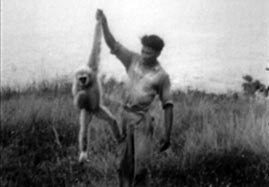
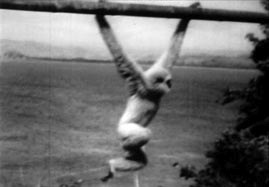
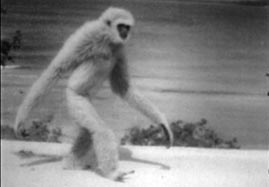
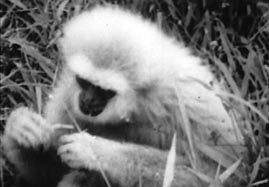
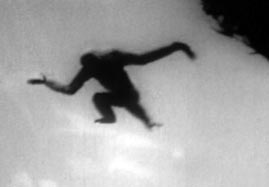 |



















































































![]()